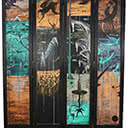North Otago Landscape
66 x 42 cm
est. $50,000 - 75,000
PROVENANCE Private Collection, Auckland
For Colin McCahon, 1967 was the year of North Otago. The works produced over this period need little by way of introduction - the artist devoted himself to reproducing the landscape in a series of repetitious studies. 'These paintings are most certainly about my long love affair with North Otago as a unique and lonely place', he wrote for the Barry Lett exhibition catalogue, 'they are also about where I am now'. They gave life to a language of abstract expressionism which sought to convey the meaning of some of New Zealand's enduring landmasses. Through the portrayal of these immutable forms, McCahon explored fundamental questions of spirituality and physical erosion.
In North Otago Landscape, the viewer is able to access the sublime quality of McCahon's work. The landscape is pared back to the point that any distinguishing features of location or basic form are unrecognisable. While it shares thematic common ground with his other North Otago paintings, some of which depict green hills, this work goes much further, to the logical conclusion of abstraction. Two horizontal lines are connected by a bold, intersecting vertical line. All is black; all is flat. Black sky and black earth frame a pale nothingness. Were it not for the title, the work could easily be unanchored from any sense of representation or purpose.
Without detail, perspective, or colour, is the landscape even still there? We sense that it is, but it is only because of the title that we know that it is. This is a reminder of the importance of the written word to inform meaning in McCahon's work, and of the extent to which we rely on this as viewers. The work is powerful and it refers to an infinite, creation-like vision of Otago, and also of the earth. Looking at it, we may find ourselves mentally squinting to imagine the hills it references. The leap we make to imagine those hills must be one of faith, or at the very least, faith in the unshakable nature of McCahon's relationship with the North Otago landscape.





